Landonography

Landonography, coined in 1919 by People's Commissar for Education Kieran Hayes (1858–1921), refers to the symbols, landmarks, icons, and myths associated with the United Commonwealth, and more broadly with the Landonism movement. The concept derives its name and inspiration from iconography – the identification, description, and interpretation of the content of images – specifically the secular western iconography movement. In 1918, following a government order during the Continental Revolutionary War, pre-war symbols and states were reevaluated and removed if found to be in violation of the ideals of Landonism and Continentalism. Seeing the need for unifying icons and commemoration of the revolution, and as a result of the looting of national artifacts by the retreating Federalists, the Government of Aeneas Warren sponsored the creation of art and demonstrations depicting key events, individuals, and Landonist values. These symbols became the first "Landonographs", and the art style depicting them eventually developed into the style of Landonist realism.
Officially sponsored by the government for the first half of the 20th century, the Landonist realism movement sought to depict and exemplify the concepts of Landonism, such as the emancipation of the proletariat, as well as the triumph of the Continentalist movement. After the death of Aeneas Warren in 1922, a key aspect of Continental mythologizing included the veneration of Warren, which developed into a cult of personality. Another key movement in the development of Continental symbols was the God-builders, who sought the creation of a meta-religious framework that used religious ritual, myth, and symbolism toward pro-Landonist aims. A number of such stories and folk heroes within the United Commonwealth, usually relating to Landonist ideals, form the basis of Continental mythology. The use of Landonographs has formed the basis of the sociological theory of the Continental civil religion. Since the early United Commonwealth, these symbols and landmarks have played an important role in art, national identity, and propaganda. Although often sanctioned by the Continental government, Landonographs should not be confused with the National symbols of the United Commonwealth, which are legally recognized symbols representing the country as a whole to the international community, including its flag, emblem, and anthem.
Events
One of the key aspects of Landonography is the mythologization of key events in the history of the United Commonwealth. Most commonly, this includes events leading up to, or being a big part of, the Continental Revolution, the early history of the United Commonwealth, or events in the lives of the key founders of the United Commonwealth. Depicting these events became a key component of Landonist realism, often leading to increased embellishment in artwork.
| Event | Description | Image |
|---|---|---|
| Crossing of the Detroit | On 1 November 1916 a caravan of Continentalist revolutionaries secretly crossed the Detroit River under the cover of night. At the time of this event, numerous revolutionaries had been exiled or fled the country to nearby Canada, but upon the escalation of tensions across the border, the Continentalists of Canada elected that it was time to return to aid in the start of the revolution. At the start of November, the revolutionaries departed from Windsor, Ontario on makeshift rafts and boats to head for the city of Detroit, and to hopefully sneak past border patrols. The group succeeded, transporting much needed arms and ammunition, and ambushing the garrison of the city of Detroit. As a result the swift Siege of Detroit began and ended in a Continentalist victory, in what many would call the “first shot of the Revolution”. The midnight crossing was quickly eulogized and romanticized as the new version of George Washington's crossing of the Delaware River. Members of the crossing included Emalia Holliday and George Tyler, who became rising stars in the Continentalist movement for their bravery. | 
|
| Tournesol Tour | Following the 7th Party Congress in August 1916, Aeneas Warren embarked on a tour of the Midwest while pursued by federal authorities. Accompanied by Zhou Xinyue and early Continentalist followers such as Nikita Neosha, Warren fled to Tournesol, where he toured the country delivering speeches and building the Continentalist movement. On one occasion, Warren and Zhou narrowly escaped capture in a stolen Cadillac Type 53. Warren also delivered a famous speech on the banks of the Neosho River. The Tournesol Tour would be romanticized as the prelude to the revolution, and is often depicted as a daring chase between Warren and the Federalists. | 
|
| Crosley Field Riot | In early 1918 a riot broke out at Crosley Field, home of the Cincinnati Reds, after a veterans march congregated at the stadium. The riot broke out after a hot dog vendor refused to serve the spectating men, calling them "vile traitors". A brawl would break out, which later developed into a police standoff, as the veterans barricaded the stadium. This event is sometimes regarded as the first battle of the Revolution, and began formal insurrection across Ohio. | 
|
| Storming of Old Rookery | In late 1917 the provisional Landonist city council formed by Aeneas Warren voted to seize control over the state functions of Illinois. The most dramatic event in the coup would be the assault on the heavily fortified city hall of Chicago, nicknamed the "Old Rookery". Following this event, the Provisional Socialist United Commonwealth was formed, dividing the country into two warring states. This event has been ceremonially recreated on numerous occasions. In 1920, to celebrate the anniversary of the event, a mass demonstration took place in Chicago in which the event was recreated, involving thousands of soldiers, workers, dancers, and other performers. | 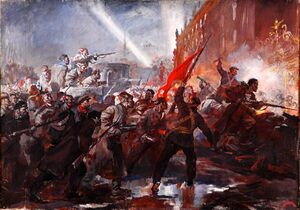
|
| Proclamation of the Continentalist States | On 1 May 1921 the United Commonwealth of Continentalist States was officially established, following the ratification of the Union Treaty, which united the provisional socialist United Commonwealth, Okaloosa, and the Congregationalist States. The union was declared at the 1st National People's Congress. | 
|
Folklore
The United Commonwealth has numerous national and regional myths and folktales, which only became further embellished and popular after the Continental Revolution and the adoption of mass media. Although Seamus Callahan initially censored folklore studies in the late 1920s as part of the country's first five year plan, it was later argued that folklore was the traditional tales of the working classes, and could be used to promote Landonist values. Since then, numerous legendary figures and tales have been eulogized as part of the history of the United Commonwealth.
| Legend | Description | Image |
|---|---|---|
| Steelman Joe | "Steelman Joe" is a legendary folkhero associated with steelworkers, believed to have been spread to the United Commonwealth by Croatian immigrants working in the Pittsburgh area steel mills. He is said to have been the bravest and most hardworking steelworker who ever lived. Differing stories recount that he was born in an iron ore mine and raised in a furnace, or that he was made out of steel. He is said to have been either 7 feet tall, or as tall as a smokestack, and his shoulders were the size of mill doors, and his hands like buckets. He could eat hot steel soup and ingots like meat, and could drink a gallon of water in one swallow. Joe had the strength of 29 men, and could work 24 hours a day. He was so strong he often bent and shaped steel with his bare hands. Among the various legends associated with Steelman Joe is the "Miracle of 1918": a miserly mill owner in Pittsburgh ordered all his employees to work through Christmas, but Steelman Joe volunteered instead to secretly do all the work so that the employees could go home to their families. At the end of the year the mill owner and his cronies came to collect the steel produced, but instead the workers arrived and seized the plant for the Continentalist cause. It is also said he once caught a collapsing crane, saving those the crane was about to crush, and on another occasion, pulled a loose train up hill to safety. | 
|
| Red Roy | According to legend, during the early days of of the Continental Revolution, a mysterious cavalryman named "Red Roy" rode across the Midwest spreading news of the revolution. Red Roy was said to have been a veteran who was disenchanted with the Federalist government, and in some accounts he leads a band of rogue revolutionaries, made up of veterans and cowboys, that patrols the Midwest. On one occasion he rode across Illinois in a single night to warn Aeneas Warren of a counterrevolutionary plot, and on another he miraculously jumped across the Arikaree Breaks in Tournesol. Red Roy is said to have been a menace to the greedy land barons of the Midwest, robbing their farms and giving their riches to the poor. His trusty horse is said to have been named "Secretariat", inspiring the Continental legislators, and his band of soldiers became known as the "Red Rangers". Today this name lives on in a named regiment of the Continental Army. | 
|
| Starman | Starman is a legendary humanoid alien who crash landed in a field in the Midwest. The Starman initially scared the inhabitants of the small town, but then he hoisted the red banner of labor, and explained that he came from an alternate, future dimension, where communism has already been achieved worldwide. The Starman describes the futuristic utopia under communism, and explains that global communism is what allows mankind to explore the galaxy. The people ask to take Starman to meet the President of the United Commonwealth, who in the story is usually Seamus Callahan, but the Starman explains he must go, and instead says the Continental people will visit him soon once they've mastered space travel. The workers of the local factory help repair the Starman's spaceship, and he soon departs. Before leaving he points out several young children, saying they are the future of space travel and will be the first astronauts. | 
|
| Continentia | Continentia, or Comrade Continentia, is a female national personification of the United Commonwealth. She first emerged as a symbol of the nation and its ideals in the early 1920s in Continental propaganda, although she is believed to have been based on a figure of the Continental Revolution. According to legend she is based on a young woman who ran out to raise the red banner during the Battle of St. Louis. Continentia is often depicted holding a flag or a torch, which is said to represent the United Commonwealth lighting the way toward communism. Depictions vary wildly, but she is often seen wearing a laurel wreath, Phrygian cap, or mariner's cap, holding a hammer, sickle, or star, or is depicted as a worker or everyday citizen. In ceremonial depictions she is seen wearing Greco-Roman style robes adorned with red stars. | 
|
| Bigfoot | Comrade Bigfoot is a purported ape-like creature said to inhabit the forests of the United Commonwealth. He appears in folklore across North America as a legendary cryptid, while in the United Commonwealth additional legends exist stating that Bigfoot supported the Continental Revolution. After an attack by the Federalists resulted in a small town in Appalachia being burned down, the survivors fled into the forest without supplies. They were saved when Bigfoot arrived with a herd of cattle the Federalists had previously tried to seize. Bigfoot saluted the Continentalists with a raised fist in the air, then disappeared back into the forest. | 
|
Artifacts
Documents
The United Commonwealth houses several important state documents, written artifacts, and archives, which are housed in the National Archive Building in Chicago. In addition to the specific documents listed below, the nation also houses the complete archive of the Revolution and Continental history, personal records of state and historical figures, and several foreign documents, such as an original version of the 1297 Magna Carta confirmed by Edward I of England.
| Place | Description | Image |
|---|---|---|
| Union Treaty | The Treaty on the Creation of the United Commonwealth of Continental States, commonly known as the Union Treaty, which created the modern United Commonwealth via the union of the Provisional Socialist United Commonwealth, Okaloosa, and the Congregationalist States. The document was signed 20 April 1921 and went into effect on 1 May 1921. | 
|
| Constitution of the United Commonwealth | Each of the United Commonwealth's three state constitutions are considered important artifacts, and are all publicly displayed. | |
| Continental Decrees of 1917 | In 1917 the Government of Aeneas Warren passed a series of continental decrees, including a decree on peace, land reform, and the establishment of workers' councils and government, which effectively began the Continental Revolution. | 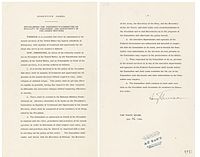
|
Objects
| Place | Description | Image |
|---|---|---|
| Sacred Red Banner | According to legend, the "Sacred Red Banner" was first sown in the 1870s and may have been present at the Pullman Strike. It was subsequently hung up as a decoration in the Chicago hall of the Socialist Party for the next few decades. During the seizure of the state of Illinois in 1917, the flag was handed to Aeneas Warren. It is said that Warren was attacked by city police and shot at, but miraculously he avoided being shot while holding the flag. The flag was risen over Old Rookery after its seizure by Continentalists. The flag was last flown on 1 May 1921 to announce the creation of the United Commonwealth of Continentalist States. Pieces of the flag also accompanied the first moon landing in 1969. Today the remains of the flag are on display at the National Museum of the United Commonwealth. | 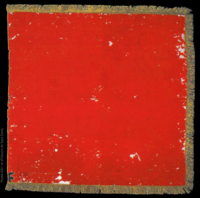
|
| Freedom Plough | During the Southern Campaign of the Continental Revolutionary War, Federalist officials in Macon, Georgia ordered people's ploughs to be seized in order to melt them down for ammunition. According to legend, the ploughs seized from the families loyal to the Continentalists refused to melt easily. The Federalists abandoned the endeavor, and the town's equipment was rescued by Continentalist forces. One such plough, nicknamed the "Freedom Plough", was preserved as an artifact of the struggle to liberate the South, and is currently on display in the National Museum of the United Commonwealth. | 
|
| Continental Cornerstone | The Continental Cornerstone was the first stone ceremonially laid in the creation of the National People's Congress. The stone was first laid in 1918 as part of a 1 May ceremony, during which time a statue of Karl Marx and Friedrich Engels was also raised. The stone now sits outside the main facility in the gateway to the complex. | 
|
| Sword of Isaiah Landon | The sword of Isaiah Landon is a Model 1850 Army Staff & Field Officers' Sword, believed to have been constructed in 1861 during the American Civil War. The sword was gifted or inherited by Isaiah Landon, and during his tenure as commander-in-chief of the Second California Republic he donned the sword ceremonially. | |
| Warren's Getaway Car | Warren's Getaway Car, also known as the "Silver Bullet" (in reference to Isaiah Landon's "ballot or bullet" speech), refers to the getaway cars used by Aeneas Warren and Zhou Xinyue during the Tournesol Tour. The car was shot at by Federalist forces, but according to legend the revolutionaries inside were unscathed (or alternatively had already abandoned the car). Today the car is preserved in the National Museum of the United Commonwealth. | 
|
Places
Several locations in the United Commonwealth have been designated as national landmarks of great historical importance or veneration.
Chicago
| Place | Description | Image |
|---|---|---|
| Crimson Square | Crimson Square is the main square in central Chicago, home to the important government buildings and monuments of the United Commonwealth. Besides hosting these many buildings, the Crimson Square is most famous for its necropolis, which is the resting place of many of the country's highest ranking officials. The square first became the site of mass graves of the Continental Revolutionary War in 1918. Since then, burial in Crimson Square has been designated the country's highest honor, and is home to Heroes of the United Commonwealth, the highest ranking leaders of the revolution or Continental government (e.g. Seamus Callahan, Jack Spruance, Nikita Neosha), and esteemed international socialists (e.g. Inessa Armand, Fritz Heckert, leaders of the communist uprising in Russia such as Felix Dzerzhinsky). | 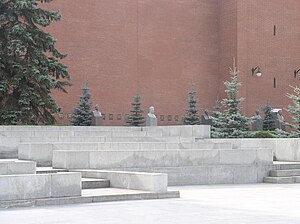
|
| National Sepulchre | Located on the former Goose Island and built in 1949, this structure serves as the mausoleum of Aeneas Warren. The tomb is overseen by guards of honor, who remain at the tomb at all times. | 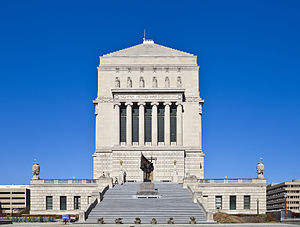
|
| National People's Cemetery and the Tomb of the Unknown Soldier |
The National People's Cemetery was formally established in 1924 from the union of several smaller plots of national land outside Chicago. The site had historically been home to mass graves created during the Revolution, and from there developed into a cemetery of high honor for fallen soldiers, revolutionaries, national heroes, and government officials. The National People's Cemetery is considered the second highest honor behind burial in the Crimson Square itself.
The site also houses the Tomb of the Unknown Soldier. Created in 1921, this memorial houses the remains of unknown soldiers who had fallen in the Revolution, and since then the tomb has been designated as a monument dedicate to all service members whose remains have not been identified. The tomb is guarded by guards of honor, known as Sentinels, who patrol the site at all times. |
 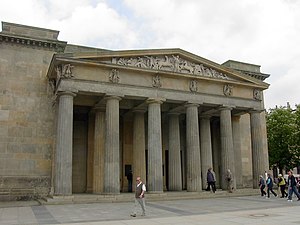
|
Life of Aeneas Warren
| Place | Description | Image |
|---|---|---|
| Birthplace of Aeneas Warren | The birthplace and childhood home of Aeneas Warren, located in Pikesville, Kentucky, is preserved as a national monument and museum. The house itself is a shotgun-style home with only three rooms, while the grounds surrounding the home include a museum and reconstructed town, with depictions of scenes in the life of Warren. | 
|
| Railcar of the Revolution | Warren had a specially built railcar, nicknamed the "Railcar of the Revolution" or "Railcar One". This railcar was equipped with broadcast equipment, and was used as part of a nation-wide tour of the United Commonwealth in 1922. The railcar continued to be used sporadically until about 1950. Today the railcar is on display in the National Museum of the United Commonwealth. | 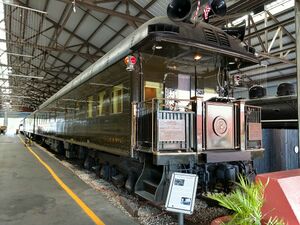
|
| Warren House | The Warren House is an estate in north Chicago, designed by architect Frank Lloyd Wright, once used as the home of Aeneas Warren. The site was used by Warren as a personal residence for when he was vacationing or retired from government functions, as otherwise he resided in the official residence in downtown Chicago. The house was used for its longest extent in 1922 in the leadup to Warren's death. The house now functions as a museum and educational center. | 
|
